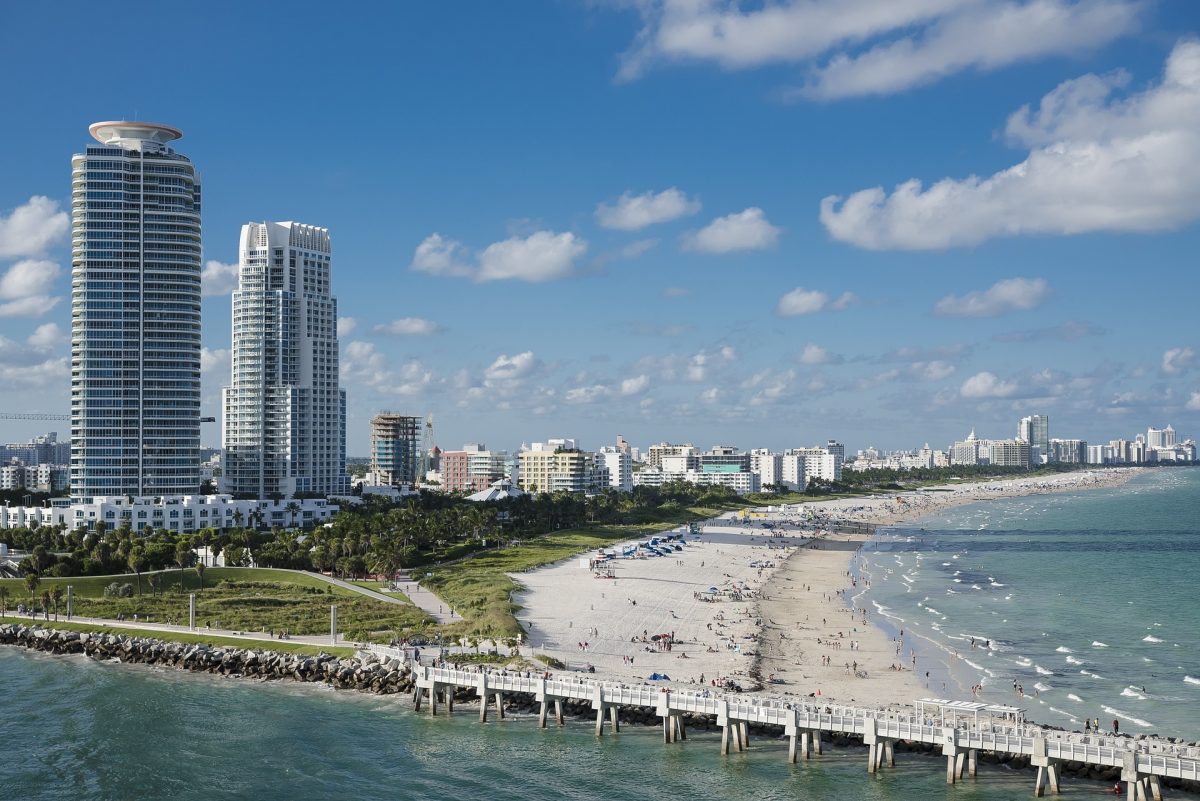What To Expect From The Weather At Miami Beach, Florida

You don’t need to think hard to find excellent reasons to visit Miami Beach. Cocktails, girls in bikinis, and cruises are only a few things that instantly come to mind. Miami Beach has everything you need to have a pleasant vacation on the beach.
The Miami Beach weather has all the qualities of a long summer, interrupted by a period that passes as a late spring in northern regions. This is why travellers visit this popular beach destination in Florida no matter the season.

Photo from Unsplash
Unless you don’t mind wearing waterproof boots and raincoats during your vacation on the beach, make sure you plan your trip before rushing to this corner of Florida. Weather in Miami Beach tends to be inconsistent at times, so check the Miami Beach weather radar once in a while to stay updated.
1.
Miami Beach Weather By The Season
Spring brings pleasant weather with long sunshine and moderate rainfall, at least by the local standards, until May. Unless your vacation in Miami Beach is during spring break, you’ll benefit from reasonable deals and won’t need to use elbows to find your way through a cocktail bar.

Photo from Pixabay
Summer in Miami Beach can be described in three words – hot, wet, and humid. Air temperatures are at their peak, while summer rains in May spring up throngs of mosquitoes.
During the summer vacation season, prices are higher than usual and plenty vacationers are expected. If you’d like to stay in a more affordable hotel, make sure you book as early as possible.
The autumn season features mostly pleasant air temperatures and, starting from October, lesser rainfall. Holidaymakers dwindle, which makes this season ideal for enjoying the benefits of good weather and affordable deals.
Winter here exists only in name. It doesn’t put off many travellers from enjoying the warm sea. Although the lowest annual temperatures and winds that gain in strength may make you feel somewhat chilly.
Winter is also a popular season for vacationing in Miami Beach, so expect high rates. Moreover, start touring bars and restaurants early to increase the chances of securing a table during the winter season.
2.
Miami Beach Average Air Temperatures
Average air temperatures in winter typically vary from 15°C/59°F to 25°C/77°F. Mid-afternoons in December and February are usually warm, while the rest of the day is comfortable. Expect crisp early mornings in January until the first half of February.

Photo from Unsplash
Weather in Miami Beach features higher daily temperatures in spring. Average air temperatures fluctuate from 16°C/61°F to 27°C/81°F in March and between 19°C/66°F and 28°C/82°F in April. Typical temperatures of air vary between 21°C/70°F and 30°C/86°F in May.
Miami Beach in spring has generally pleasant weather, but it does have its occasional hot days.
Come summer, the heat might make you wish to take off your skin. If bearing hot weather from before noon to late evening is too much for you, plan how to spend some quality time indoors in air-conditioned rooms during your summer vacation.
Average air temperatures during summer are consistent in this part of Florida, commonly varying between 24°C/75°F to 32°C/90°F.
Air temperatures in September are similar to those during summer months. Other autumn months feature somewhat lower temperatures at Miami Beach. Average temperatures of air fluctuate from 22°C/72°F to 29°C/84°F in October and between 18°C/64°F to 27°C/81°F in November.
From October, hot afternoons and early evenings are a matter of the past in Miami Beach. Days are warm, while comfortable temperatures prevail from late evenings to early mornings.
3.
Average Sea Temperatures in Miami Beach
Regarding the sea temperature, you will feel comfortable while making fishes and other aquatic creatures company and collecting seashells all over the year. Miami Beach has the lowest average temperature of the sea in January, which is 22°C/72°F.

Photo from Pexels
That means that the sea temperature commonly fluctuates from 20°C/68°F to 24°C/74°F this time of year.
If you come to Miami Beach to refresh yourself by swimming or diving in August, you have chosen the wrong month. The average sea temperature at Miami Beach during the hottest annual month is 30°C/86°F, which means that you are more likely to refresh yourself while sunbathing.
4.
How Often Does It Get Wet In Miami Beach?
Miami Beach has two distinctive seasons when it comes to rain. The dry season lasts from November to April, while the season with heavy rains takes place from May to October.

Photo from Pixabay
Miami Beach receives the lowest rainfall during the winter months – December, January, and February. During this period, this destination receives around 150mm/nearly 6in of liquids from the sky.
In spring, the situation becomes a little more interesting. Weather brings nothing new to Miami Beach in terms of precipitation in March (60mm/less than 2.5in). April is barely different in this regard.
From May until October, you will need to carry an umbrella in one hand and a parasol in the other when going to the beach. During the last spring month, clouds unleash over 150mm/6in of rainfall on Miami Beach on average.
The rainiest month during the wet season is June, in which the vacation destination in Florida receives nearly 240mm/9.5in of precipitation on average. July and October feature around 150mm/6in of rainfall, while August and September are somewhere in the middle – usually around 200mm/8in.
In November (70mm/less than 3in), you can leave an umbrella at home.
5.
How Long Does The Sun Shine Here?
No matter how much it rains over Miami Beach, you will have more sunshine than rain during your vacation. Even if you visit during the gloomiest of months, the sun will shine down on you at least 6 and a half hours per day.

Photo from Pixabay
April has the longest mornings with almost 9:30 sunshine hours of 12:45 daylight hours. In October, which is the gloomiest month, Miami Beach receives 6:30 hours of sunshine of 11:30 hours of daylight on average.
During the rainy summer months, you’ll still benefit from around 8:30 hours of sunshine per day on average. Winter, early spring and early autumn months typically feature between seven and 8:30 hours of sunlight per day.
6.
Miami Beach Extreme Weather
At times, you may need a massive chain and a boulder to secure yourself when a hurricane strikes Florida. It isn’t likely that a hurricane will hit Miami Beach, or Florida for that matter, while you make sand castles on the beach. Still, acquaint yourself with the safety procedures, just in case.

Photo from Pixabay
The hurricane season corresponds to the wet season in Miami Beach. However, during the months of August to October is when a hurricane most likely occurs.
Statistically speaking, hurricanes make one landfall on the US East Coast a year. And there is a 40% chance that it will hit someplace in Florida. So, the likelihood of losing your parasol while you are on the beach in Miami Beach is low in general.
7.
Things You Should Pack For A Vacation At Miami Beach
One thing is sure about the Miami Beach weather. Whatever else you may need to make room for in your luggage, don’t forget sunscreen and sunglasses.

Photo from Unsplash
Light clothing, such as shorts, skirts, shirts, and sandals, is the type of clothing you will need for vacationing here year-round. Only subtle temperature and dramatic rainfall variations may have you add something up on occasion.
When traveling to Florida and Miami Beach in the first half of spring, rain isn’t likely to bother you much. Only in May, you are very likely to need an umbrella or a raincoat while getting around.
In summer, you’ll wear a raincoat and swimsuit underneath most of the time in Miami Beach, Florida. Besides, bring larger quantities of sunscreen and apply them often. Not even clouds can prevent you from getting sunburns here.
Unless you have a thick skin, bring long sleeves and trousers this time of year. Mosquitoes are rife after rain at Miami Beach.
You will be glad to have an umbrella, raincoat, and maybe boots until October when thunderstorms and downpours come.
In winter, leave your equipment for rain back home. Replace it with light sweaters, jackets, and shoes to feel comfortable in the evening.
Final Tips And Thoughts
For a higher chance to quickly switch between water skiing and diving if you are a rookie, come to Miami Beach between November and March. During this period, the strength of wind tends to increase over 20kmh (12.5 mph), which is a moderate breeze.
If humidity isn’t much of a concern to you than wind, you will have a great time in Miami Beach between April and October. It feels muggy, if not oppressive, most of the time.
Short spring (March and April) and even shorter autumn (November) are the best times for vacationing at Miami Beach. Vacation deals, crowds, and weather work in your favour during this period.
Plus, you won’t need to choose between swimming, shopping, visiting bars and else. You can do everything you wish when you wish it.
Not much of a beach person? You can check out The Best Theme Parks In Orlando, Florida instead!

